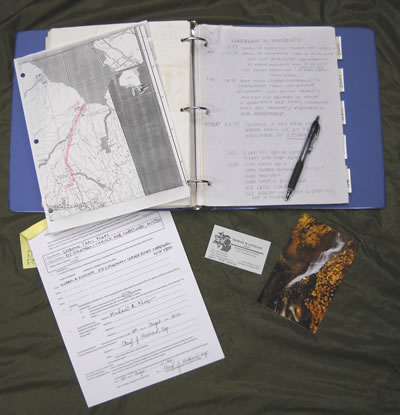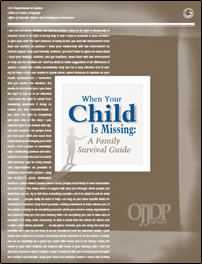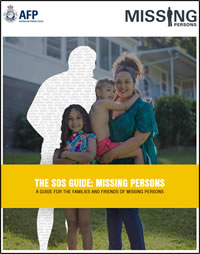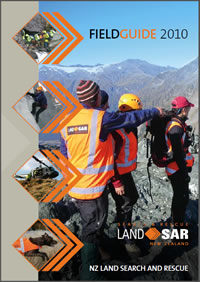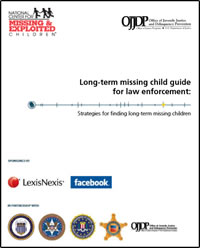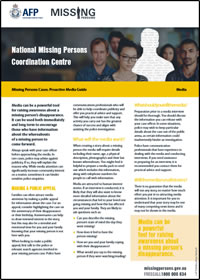
You're here: MibSAR :: M-P Sourcebook Table of Contents :: What To Do
What to Do and What Not to Do
When a Loved One
Goes Missing
| << Table of Contents | Next Chapter >> |
 |
|
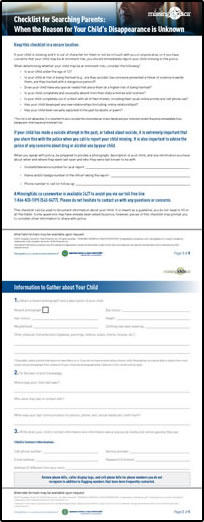 |
|
| What do I do when a person goes missing?, by the Michigan State Police (MSP) Missing Persons Coordination Unit (MPCU) | |
The Michigan State Police (MSP) Missing Persons Coordination Unit (MPCU) offers some great suggestions for what friends and families should do when a loved one goes missing.
What do I do when a person goes missing?, by the MSP Missing Persons Coordination Unit (MPCU), outlines several important things that you should do — and not do — when a loved one goes missing.
The MSP's recommendations are outlined below, with additional suggestions from Michael Neiger in shaded text boxes.
What to do:
- Do not panic. They may have simply forgotten their phone, got caught up in some activity or plain forgot to check in.
If you are fortunate and your loved one returns, consider proactively creating an "ID KIT" for them

Team MibSAR Quickly reporting a missing person to the authorities — especially a child or young adult — is often critical to the outcome of an investigation.
To expedite this process, consider keeping the child or young adult's personal information on-hand — including DNA, fingerprint, and scent exemplars — using one of the many ID Kits available for free.
To learn more about ID Kits, visit this page.
— Michael Neiger
Just the Facts, Just in Case, by the New York State Division of Criminal Justice Services, Missing and Exploited Children Clearinghouse, 2004, 6 pages
- Contact friends and family to ask if they have any knowledge of the missing person's whereabouts.
- Keep your phone within reach, make sure your ringer is on and the phone stays fully charged, in case they try to reach you.
- Once you have sufficient reason to believe they are in fact missing, contact your local law enforcement agency to make a missing persons report.
- Depending on the policy of the police department, you may be asked to wait a sufficient amount of time (24 - 72 hours) before they will take your report. This should NOT apply to missing juveniles, missing elderly persons or persons suspected to be a victim of foul play.
- Keep in mind, it is NOT illegal for an adult to voluntarily go missing. The police have certain rules and regulations to protect privacy in case this is the situation. Don't get frustrated by the police sticking to their guidelines; remember they are in place for a reason.
Keep a journal on your loved one's case
Team MibSAR Keeping accurate, detailed, contem-poraneous records of everything — every detail — in your search for answers to the disappearance or murder of your loved one is critical.
It will help keep you focused and organized. It will help you keep others accountable for what they tell you they are going to do.
And if foul play ends up being involved in your loved one's disappearance, you will have an excellent set of records — with a solid chain of evidence — that may allow a prosecutor to use them as probable cause for a search warrant, or admit them into evidence in courtroom trail.
To learn more about how to keep a journal on your loved one's case, visit this page.
— Michael Neiger
Always keep a journal in ink, along with supporting documents Always keep a to-do list so everything gets done, and that you follow-up on things that police officers and detectives have promised to do for you. Always keep a memo book listing what you've done and when, and what needs to be done going forward. It will help keep you motivated and forward looking.
- If the missing person is vulnerable (i.e., under 18 years of age, over 65 years of age, suffering from physical or mental illness, depressed/suicidal or the disappearance is completely out of character) report the disappearance to police immediately if your suspicions are aroused.
It's never too soon in these instances and time may be of the essence. This could also include someone on life-saving medication who has not taken their medicine with them. You can contact police and the local media to ask for help in publicizing their story. REMEMBER ... it's never too soon.
Learn more about missing-persons case management
Team MibSAR A list of several free books about missing-persons cases can be found on this page.
— Michael Neiger
Missing: A Guide for Families and Friends of Individuals with a Mental Illness Who Have Gone Missing, by Christine Lafond, Stephanie Scherbain & Gita Sud, Mental Health Education Resource Centre of Manitoba, Canada, 2006, 36 pages When Your Child Is Missing: A Family Survival Guide, by the Office of Juvenile Justice and Delinquency Prevention (OJJDP), NCJ 228735, Fourth Edition, 2010, 114 pages.
- Police will need details like the missing person's photo, date of birth, address, physical description, clothing last seen wearing and other details of the life of your missing person.
Make it a routine to take at least one head and shoulders photograph of your loved ones each year. Please be complete with the information you provide to law enforcement; it's always better to have too much information, than not enough.
Missing-person checklists

Team MibSAR To make sure you or the police don't forget to do something, or overlook an important piece of information, use one or more the missing-person checklists on this page.
— Michael Neiger
Missing-Child, Emergency-Response, Quick-Reference Guide for Families, by the National Center for Missing & Exploited Children (NCMEC), 2011, 2 pages
Create and share a missing-person poster
Team MibSAR To more-widely publicize your loved one's case, consider creating a missing-person poster and sharing it on social media and with local radio stations, TV stations, bloggers, and newspapers.
Printed posters can also be posted in the area where your loved one went missing.To learn more about leveraging missing-person posters on behalf of your loved one's case, and about getting a free, social-media-friendly, digital-and-print, missing-person poster from Team MibSAR, visit this page.
— Michael Neiger
Ada Quintal's Missing-Person Poster
Rewards for information
Team MibSAR To learn how to leverage a reward on behalf of your missing loved one's case, visit this page.
— Michael Neiger
The SOS Guide: Missing Persons — A Guide for the Families and Friends of Missing Persons, by the National Missing Persons Coordination Centre (NMPCC), Australian Federal Police (AFP), 2017, 34 pages
- Keep in mind, police may request your assistance in getting bank records, social media account information and cell phone records for your missing person as well.
- Down the line, police may ask for additional information like dental records and DNA samples. Keep in mind there is a possibility your loved one could be found deceased, and outside of your local jurisdiction.
You would never want your loved one to be kept in a morgue or buried as an unidentified person. These records are kept on file in case such an event occurs.
- Family reference DNA samples can also be taken [from relatives — MAN]. This is a non-invasive swab taken from the inside of the cheek of a potential donor. The DNA is entered into the CODIS DNA databank and can be cross-referenced with unidentified human remains samples that are also entered.
Important databases to get your missing loved one entered into
Team MibSAR To learn more about missing-person databases, visit this page.
— Michael Neiger
The National Crime Information Center (NCIC)
- Ask police to keep in touch and if they don't, phone them. Keep in mind they have other pressing cases, but don't let them forget about yours.
If they don't ask about DNA and dental records and your missing person has been gone for over 30 day, offer them up.Understanding DNA and forensic evidence

Team MibSAR If you're not sure about what can be done on your case from a evidentiary standpoint, use the resources on this page — written by some of North America's top subject-matter experts — to double-check what you've been told is possible, and not possible.
— Michael Neiger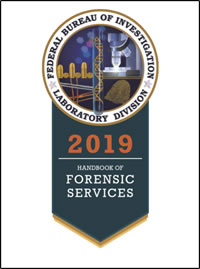
Handbook of Forensic Services, by the Laboratory Division, Federal Bureau of Investigation (FBI), 2019, 104 pages 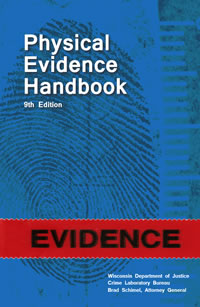
Physical Evidence Handbook, by the Crime Laboratory Bureau, Wisconsin Department of Justice, 9th edition, 2017, 312 pages -
If your missing person does not fit the foul play or endangered missing situation, the Internet provides options for you to search for your loved one.
If your missing person is deemed voluntary by your local police department, you can still conduct searches on your own. The web site NamUs, www.namus.gov, provides a platform for a nationwide posting of your missing person's photo, physical description and circumstances.The National Missing and Unidentified Persons System (NamUs)

Team MibSAR NamUs is the acronym for the National Missing and Unidentified Persons System.
To learn more about how to leverage the power of NamUs on behalf of your loved one's case, visit this page.
— Michael Neiger
The National Missing and Unidentified Persons System (NamUs)
Keep in mind you still have to involve law enforcement to have your missing person's case profiled on the NamUs site, but they will include voluntary missing cases.
- a person with a physical or mental disability;
- a person with Alzheimer's disease and dementia;
- a person in the company of another under circumstances indicating his or her personal safety may be in danger;
- a person who disappeared under circumstances indicating it was not voluntary;
- a missing child in certain situations;
- a person incapable of returning to his or her residence without assistance;
- a person missing as the result of a natural or intentionally-caused catastrophe or extraordinary accident that results in the loss of human life.
-
Canine search teams and pedestrian searches may also be an option to search for your loved one.
First, let your local police department decide if they want to do this.What to Do With Evidence the Police Won't Accept

Team MibSAR If the investigator in charge of your loved one's missing-person or murder investigation won't accept an item of potential evidence from you, don't give up and discard it.
Preserve it as best you can until your loved one's case is fully and satisfactorily closed.
To learn how to preserve evidence for future use, visit this page.
— Michael Neiger
A $20.00 lockable Sterilite Footlocker from Walmart
If they choose not to, and you are of the opinion your missing person is not missing voluntarily, there are several non-profit agencies that can assist with setting up searches.SAR Teams

Team MibSAR The Upper Great Lakes region is fortunate to have numerous volunteer ground SAR teams as well as K-9 SAR teams to assist in the search for missing persons.
To learn more about SAR resources, visit this page.
— Michael Neiger
The National Association for Search & Rescue (NASAR) 
The Ontario Search and Rescue Volunteer Association (OSARVA) 
K-9 SAR
Missing persons must be entered into NamUs — it's the law in Michigan — don't take no for an answer
Team MibSAR As of April 10, 2018, Michigan Public Act (PA) 102 of 2018 mandates law enforcement agencies in Michigan "shall immediately" enter missing individuals into the National Missing and Unidentified Persons System (NamUs). This Act clearly identifies the situations that require entry into NamUs.
According to PA 102, "missing individuals" includes the following persons/situations:
— Michael Neiger
The Great Seal of the State of Michigan
What NOT to do:
 |
|
| The Michigan State Police patch | |
- Do not panic.
- Do not wait, especially if your missing person is vulnerable; notify police as soon as you think something is wrong.
- Do not delay in searching; time can be of the essence.
How to conduct a search if the police will not
Team MibSAR While it's almost always best to leave searching to trained, equipped, experienced, physically fit, insured, certified, professional SAR operators, if you end up doing some searching on your own, the publications on this page cover some of the skills and best practices SAR operators utilize in their search for missing persons.
— Michael Neiger
LandSAR Field Guide, by Steve Schreiber and Stu Allan, New Zealand Land Search and Rescue, 2010, 82 pages
- Do not keep their disappearance a secret. The more people you tell, the more people you have looking on your behalf and the speedier the results might be.
- Do not tidy up their bedroom or car until the police have seen it, whether it's messy or not. Do not dust before fingerprints have been taken.
- Do not alter social media accounts, cell phone messages, text messages, etc. These may be important indicators of your missing person's motive or lack there of when they went missing.
Do not touch or use a missing-person's cell phones, computers or digital devices.

Team MibSAR Do not turn-off, turn-on, use, or otherwise alter any of the missing-person's digital devices, including desktop computers, laptops, tablets, cell phones, or digital storage devices such as external hard drives or thumb (flash) drives.
To do otherwise may jeopardize critical evidence about the missing-person's whereabouts — or the circumstances surrounding his or her disappearance — that a computer forensics analyst may be able to obtain after a detailed examination of the devices.
To learn more about preserving digital evidence, visit this page.
— Michael Neiger

Digital devices - Don't be put off if you don't get an immediate response from law enforcement...you know your loved one and their behaviors...follow your intuition.
Missing-person groups and organizations

Team MibSAR For a list of missing-person groups and organiza-tions, visit this page.
— Michael Neiger
Jacob Wetterling Resource Center (JWRC) 
The Polly Klass Foundation (PKF) - To avoid being the victim of a hoax, do not put your own telephone number or address on missing posters or advertisements. Instead use a police department contact number.
People may prey upon you and can be cruel. Do not get caught up in any hoaxes and contact law enforcement if you believe you have been the victim of one.Take care of yourself, seek out support

Team MibSAR The pain of not knowing what happened to a missing loved can be mental torture.
To learn about support for families with missing loved ones, visit this page.
— Michael Neiger
Living in Limbo: The Experiences of, and Impacts on, the Families of Missing People, by Lucy Holmes, Missing People, United Kingdom, 2008, 42 pages. 
Ambiguous Loss: Learning to Live with Unresolved Grief, by Pauline Boss, First Edition, 2000, Harvard University Press, 176 pages. - Do not give up, keep appealing and searching. Remember that people want to help. Try to keep your loved one's name and photo in the public eye. Your missing person is important.
Create a Facebook page to get the word out on your missing loved one's case
Team MibSAR To help get the word out about your loved one's case, consider setting up a Facebook page to promote it.
To learn how to set-up and manage a Facebook page to support a missing-persons investigation, visit this page.
— Michael Neiger
Host an event to build awareness of your missing loved one's case
Team MibSAR To help get the word out about your loved one's case, consider hosting an event to promote awareness of it.
To learn how to use an event in support of a missing-persons investigation, visit this page.
— Michael Neiger
Long-Term Missing Child Guide for Law Enforcement: Strategies for Finding Long-Term Missing Children, edited by Robert G. Lowery, Jr., and Robert Hoever, National Center for Missing & Exploited Children (NCMEC), 2016, 226 pages.
The First 48 Hours
Team MibSAR The first 48 hours a child is missing are critical for family members and investigators.
Here are some excellent tips from When Your Child Is Missing: A Family Survival Guide, by the Office of Juvenile Justice and Delinquency Prevention (OJJDP), NCJ 228735, Fourth Edition, 2010, 114 pages.
— Michael NeigerOne of the most critical aspects in the search for a missing child is the gathering of evidence that may hold clues about a child’s disappearance or whereabouts.
The mishandling of evidence can adversely affect an investigation. Similarly, the collection and preservation of evidence are key to finding a missing child.
Parents play a vital role in finding a missing child by providing critical information to law enforcement, by protecting evidence in and around the home, and by gathering information about persons or situations that might hold clues.
The following are some tips on what you should do to help law enforcement conduct a thorough and complete investigation.
Secure your child’s room.Even though your child may have disappeared from outside the home, your child’s room should be searched thoroughly by law enforcement for clues and evidence. Don’t clean the child’s room, wash your child’s clothes, or pick up your house. Don’t allow well-meaning family members or friends to disturb anything. Even a trash bin or a computer may contain clues that lead to the recovery of the child.
Do not touch or remove anything from your child’s room or from your home that might have your child’s fingerprints, DNA, or scent on it.
This includes your child’s hairbrush, bed linens, worn clothing, pencil with bite marks, diary, or address book. With a good set of fingerprints or a sample of DNA from hair, law enforcement may be able to tell whether your child has been in a particular car or house. With good scent material, tracking dogs may be able to find your child.
Do not allow anyone else to sleep in your child’s bed, play with his or her toys or computer, or use his or her bedroom for any purpose.
Law enforcement dispatch should advise you not to disturb any part of the house until a thorough search of the scene has been conducted. Investigators should let you know when their search is complete.
When Your Child Is Missing: A Family Survival Guide, by the Office of Juvenile Justice and Delinquency Prevention (OJJDP), NCJ 228735, Fourth Edition, 2010, 114 pages.
Use the media to get the word out about your loved one's plight
Team MibSAR The news media is the fastest way to raise awareness about your loved one's case.
To learn more about how to leverage the news media on behalf of your missing loved one's case, visit this page.
— Michael Neiger
One shot on the evening news is worth 20,000 posters. — Patrick Sessions, father of Tiffany Sessions, who has been missing since
February 9, 1989, in When Your Child Is Missing: A Family Survival Guide, by the Office of Juvenile Justice and Delinquency Prevention (OJJDP), NCJ 228735, Fourth edition, 2010, 114 pages.Missing Persons Cases: Proactive Media Guide, by the National Missing Persons Coordination Centre (NMPCC), Australian Federal Police (AFP), 2017, 2 pages.
Source: What do I do when a person goes missing? by the Michigan State Police (MSP) Missing Persons Coordination Unit (MPCU).
| << Table of Contents | Next Chapter >> |
People who say it cannot be done,
should not interrupt those who are doing it.
— Author unknown

If you've been able to read this
Web page...
thank a Teacher;
If you've been able to read this
Web page in English...
thank a Veteran.
— Author unknown
Copyright © 1984-
March 23, 2021
by Michael A. Neiger
Contact Michael Neiger via e-mail at mneiger@hotmail.com
Top
You're here: MibSAR :: M-P Sourcebook Table of Contents :: What To Do
